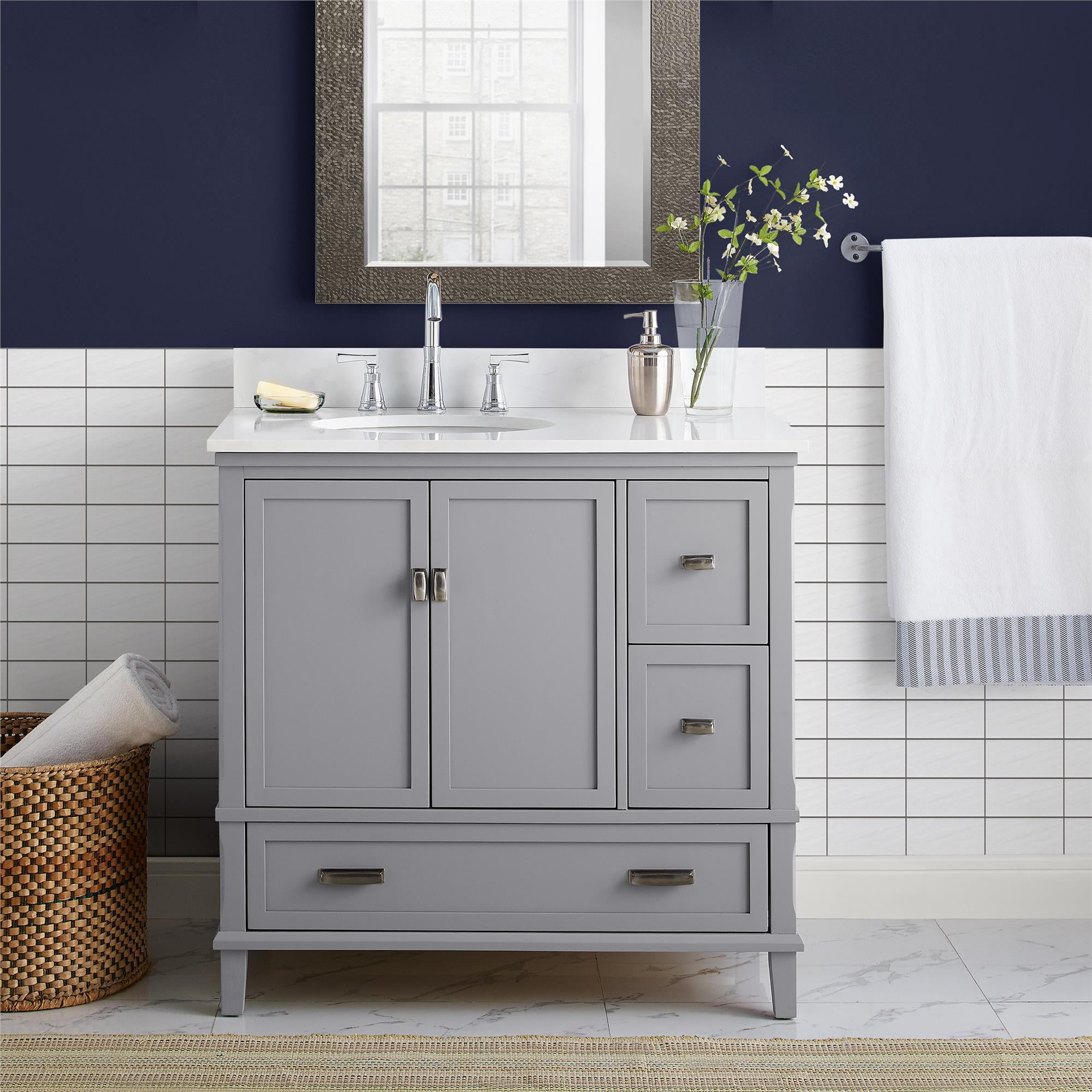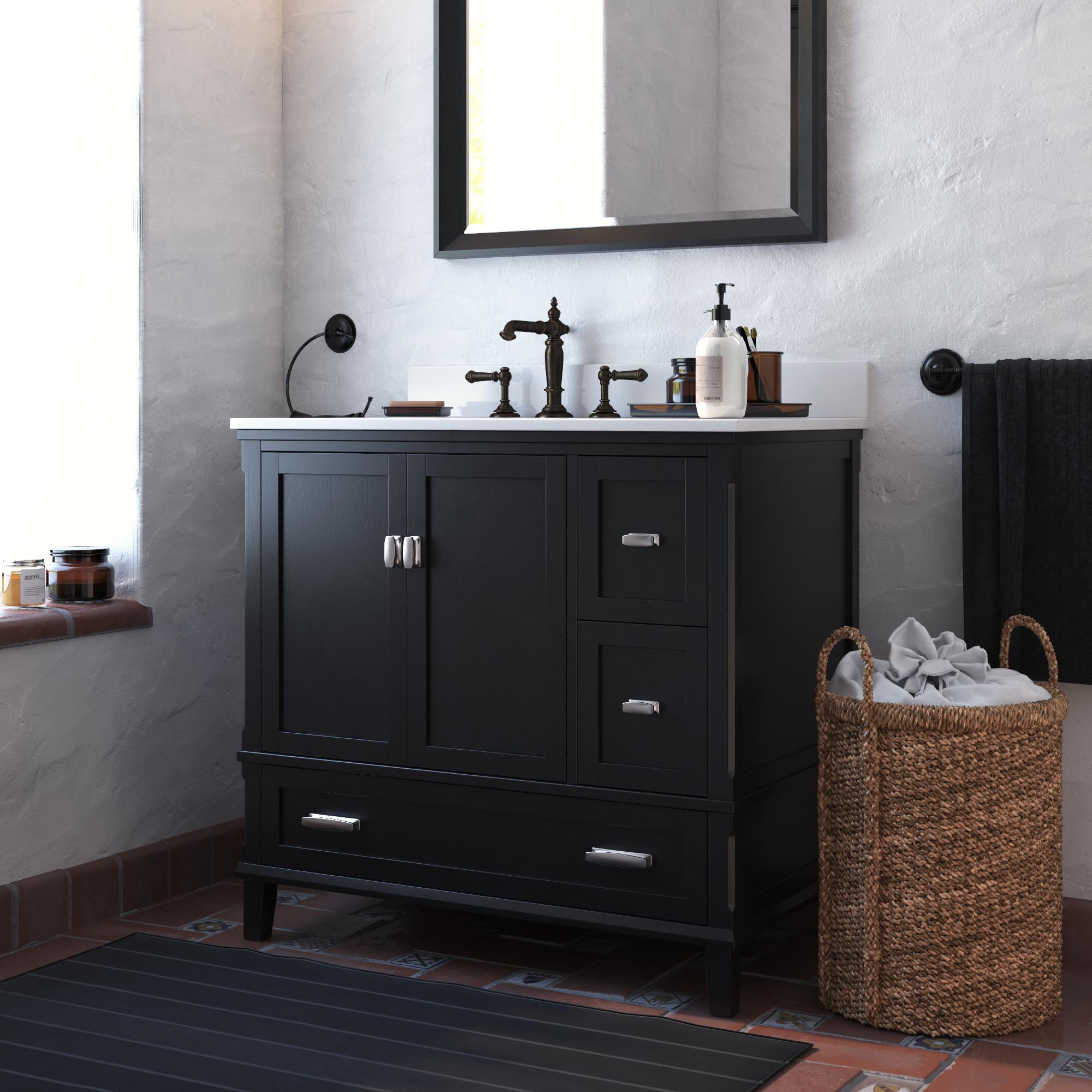The Allure of Grey

Grey is a versatile and sophisticated color that effortlessly complements a wide range of bathroom design styles. Its timeless appeal makes it an excellent choice for creating a serene and stylish sanctuary.
Grey’s Versatility in Bathroom Design
Grey is a neutral color that blends seamlessly with various design aesthetics, offering endless possibilities for creating a unique and personalized bathroom space. Whether you prefer a modern, contemporary, farmhouse, or traditional style, grey provides a solid foundation for your design vision.
Grey Complements Diverse Design Styles
- Modern: Grey pairs beautifully with sleek lines, minimalist fixtures, and metallic accents. A grey vanity with chrome hardware and a white countertop creates a contemporary and sophisticated look.
- Contemporary: Grey complements the clean lines and geometric shapes characteristic of contemporary design. Consider a grey vanity with a natural wood countertop and minimalist hardware for a modern and organic feel.
- Farmhouse: Grey’s rustic charm blends effortlessly with the warm and inviting atmosphere of farmhouse style. A grey vanity with distressed wood accents and a white countertop creates a cozy and welcoming space.
- Traditional: Grey adds a touch of sophistication to traditional bathroom design. A grey vanity with ornate hardware and a marble countertop creates a classic and elegant look.
Grey Bathroom Vanities: Design Aesthetics
Grey bathroom vanities come in various shades and finishes, offering a wide range of design possibilities.
- Light Grey: Light grey vanities create a bright and airy feel, ideal for small bathrooms. They pair well with white or cream countertops and chrome hardware.
- Medium Grey: Medium grey vanities offer a balanced and versatile option, suitable for both modern and traditional styles. They can be paired with various countertop materials, including granite, quartz, and marble.
- Dark Grey: Dark grey vanities create a dramatic and sophisticated look, ideal for larger bathrooms. They pair well with white or black countertops and brushed nickel hardware.
Grey vs. Other Popular Vanity Colors
| Color | Benefits |
|---|---|
| Grey | Versatile, timeless, complements various design styles, creates a serene and stylish atmosphere. |
| White | Brightens small bathrooms, creates a clean and airy feel, classic and timeless. |
| Black | Adds drama and sophistication, creates a bold statement, pairs well with metallic accents. |
| Brown | Warm and inviting, creates a cozy and rustic feel, complements traditional and farmhouse styles. |
Functionality and Space: 36 Grey Bathroom Vanity

A 36-inch bathroom vanity offers a balance of functionality and space, making it a versatile choice for both small and large bathrooms. It’s compact enough to fit in tighter spaces but provides enough counter and storage area for basic bathroom needs.
Optimizing Storage Space
Maximizing storage within a 36-inch vanity is essential for maintaining a tidy and organized bathroom. Here are some tips:
- Utilize drawers: Opt for a vanity with multiple drawers of varying sizes to accommodate different items.
- Employ dividers and organizers: Use drawer dividers to separate toiletries and keep them organized. Consider utilizing drawer organizers for smaller items like makeup brushes and hair accessories.
- Integrate pull-out shelves: Pull-out shelves in cabinets or drawers provide easy access to items stored at the back.
- Install a medicine cabinet: A medicine cabinet above the sink can offer additional storage for medications, toiletries, and other essentials.
Comparing Vanity Configurations
The choice of vanity configuration depends on the size of the bathroom and personal preferences.
- Single-Sink Vanities: These are the most common and suitable for smaller bathrooms. They offer a compact footprint and ample counter space for a single person.
- Double-Sink Vanities: Double-sink vanities are ideal for larger bathrooms and households with multiple users. They provide more counter space and allow for simultaneous use by two people.
- Console Vanities: Console vanities are sleek and modern, offering a minimalist aesthetic. They typically feature a slim countertop and minimal storage space, making them suitable for smaller bathrooms where space is at a premium.
Designing a Vanity Layout for Small Bathrooms
When designing a 36-inch vanity for a small bathroom, prioritize maximizing space and functionality. Here’s a possible layout:
- Choose a single-sink vanity: This will save valuable space and allow for more room to move around.
- Incorporate a medicine cabinet: This provides additional storage without taking up valuable counter space.
- Maximize vertical storage: Utilize tall cabinets or shelves above the vanity to store towels, linens, and other items.
- Consider a floating vanity: A floating vanity creates a sense of spaciousness and can make the bathroom appear larger.
Materials and Finishes

Choosing the right materials and finishes for your 36-inch grey bathroom vanity is crucial for achieving both style and durability. The materials you select will significantly impact the overall look, feel, and longevity of your vanity.
Popular Materials, 36 grey bathroom vanity
The most popular materials used for bathroom vanities include wood, laminate, and ceramic. Each material offers unique advantages and disadvantages, influencing its suitability for your specific needs and preferences.
- Wood: A timeless and classic choice, wood vanities offer natural beauty, warmth, and durability. They are available in various species, including oak, maple, cherry, and walnut, each with its own distinct grain pattern and color. Wood vanities are generally more expensive than other options but can be refinished and restored, making them a long-term investment.
- Laminate: A cost-effective and versatile option, laminate vanities mimic the look of wood or other materials at a fraction of the cost. They are highly durable and resistant to scratches, moisture, and stains, making them ideal for high-traffic areas. However, laminate vanities may lack the natural beauty and warmth of wood.
- Ceramic: A durable and hygienic choice, ceramic vanities are often used for their sleek, modern aesthetic. They are resistant to moisture, stains, and heat, making them easy to clean and maintain. However, ceramic vanities can be prone to chipping and cracking, and they are generally more expensive than laminate vanities.
Finishes for Grey Vanities
Grey vanities offer a wide range of finishes to complement your bathroom design. The choice of finish will influence the overall look and feel of the vanity.
- Matte: A classic and understated finish, matte grey vanities create a subtle and sophisticated look. Matte finishes are less reflective than gloss finishes, making them ideal for smaller bathrooms or spaces with limited natural light.
- Gloss: A sleek and modern finish, gloss grey vanities add a touch of glamour and sophistication to the bathroom. Gloss finishes are highly reflective, making them ideal for larger bathrooms or spaces with ample natural light.
- Distressed: A rustic and charming finish, distressed grey vanities offer a vintage and timeless look. Distressed finishes are achieved by creating subtle imperfections and wear marks on the surface of the vanity, giving it a unique and characterful appearance.
Grey Vanity Styles and Materials
The following table summarizes popular grey vanity styles, their associated materials, and finishes:
| Style | Material | Finish |
|---|---|---|
| Modern | Laminate, Ceramic | Matte, Gloss |
| Traditional | Wood | Matte, Distressed |
| Contemporary | Ceramic, Wood | Gloss, Matte |
| Rustic | Wood | Distressed |
